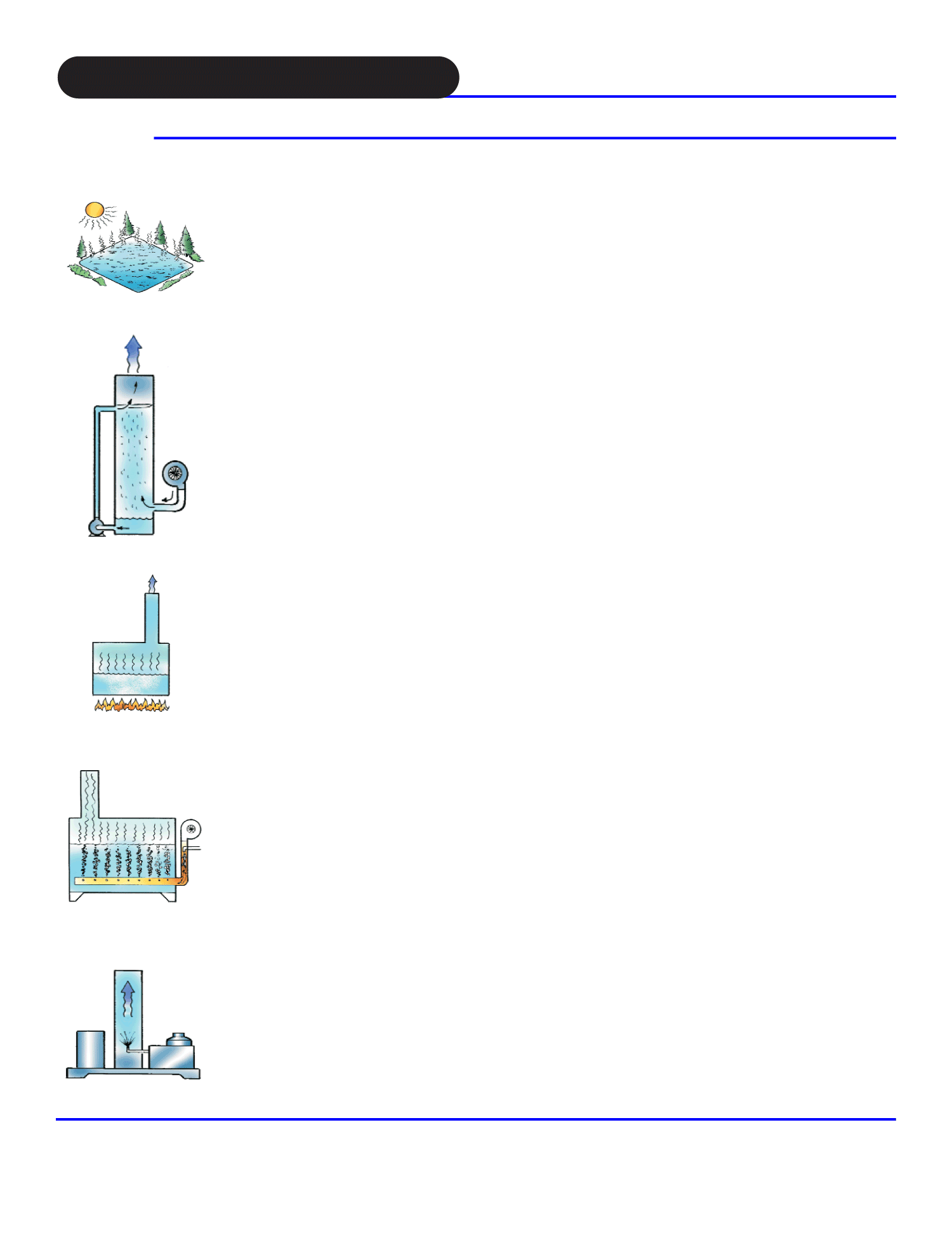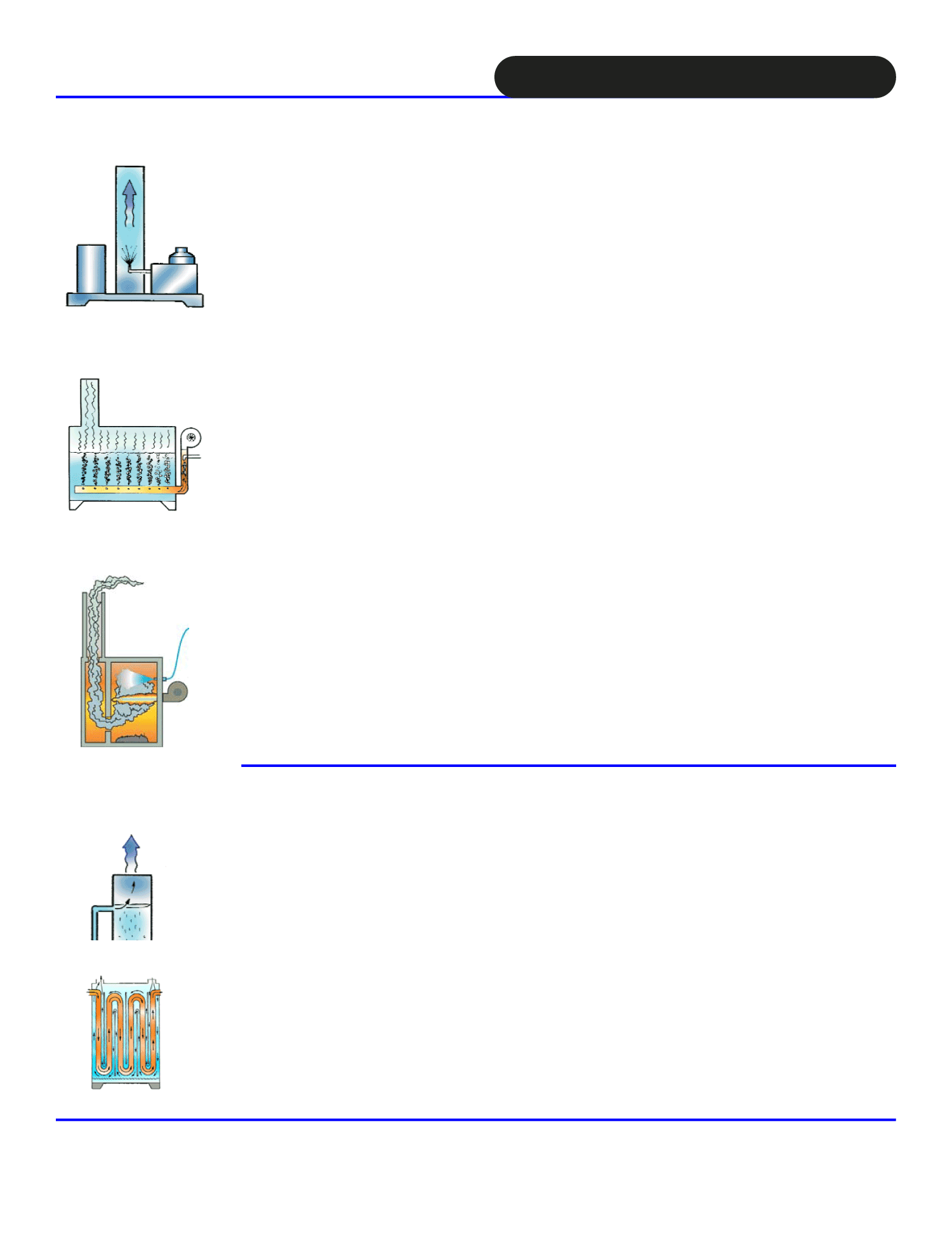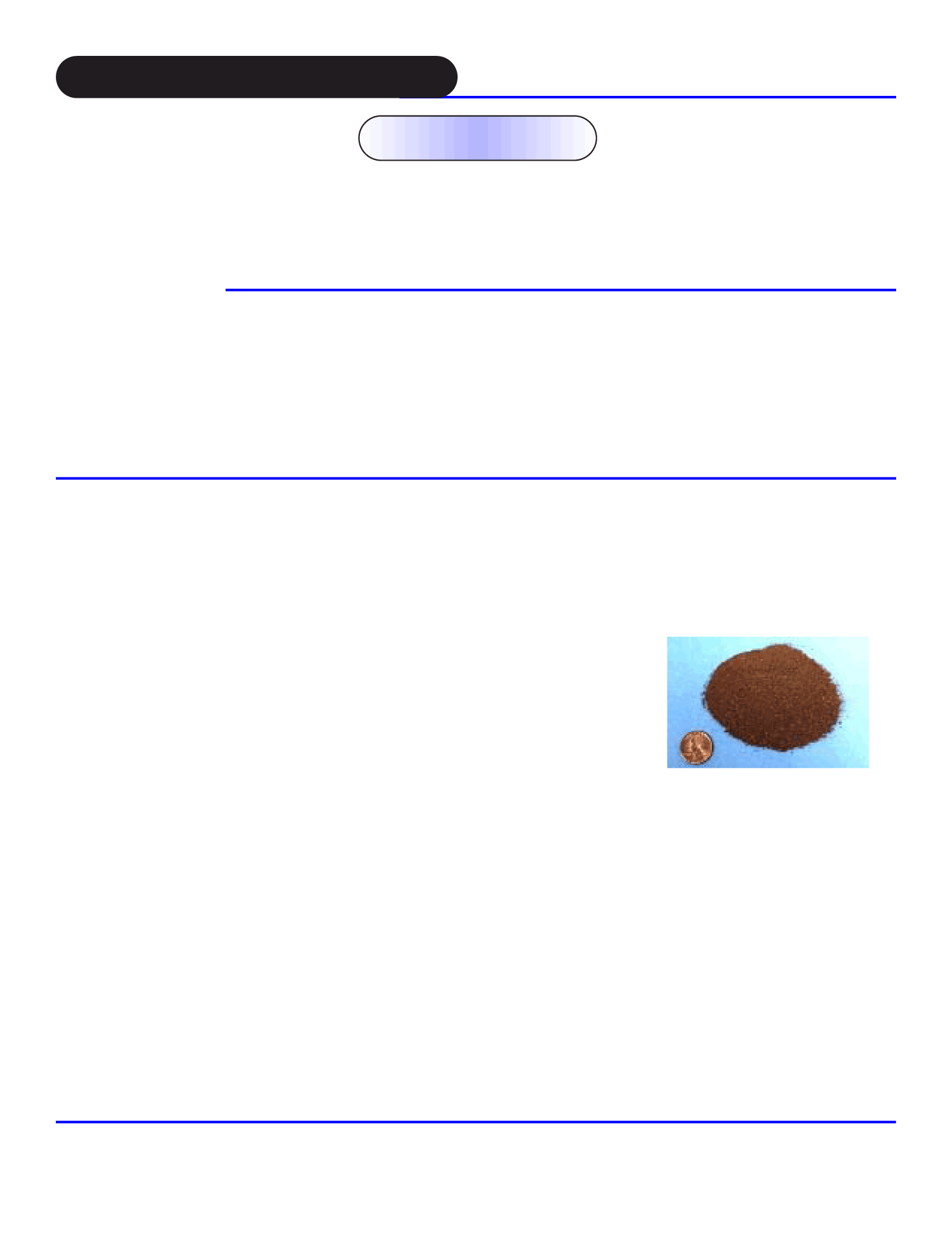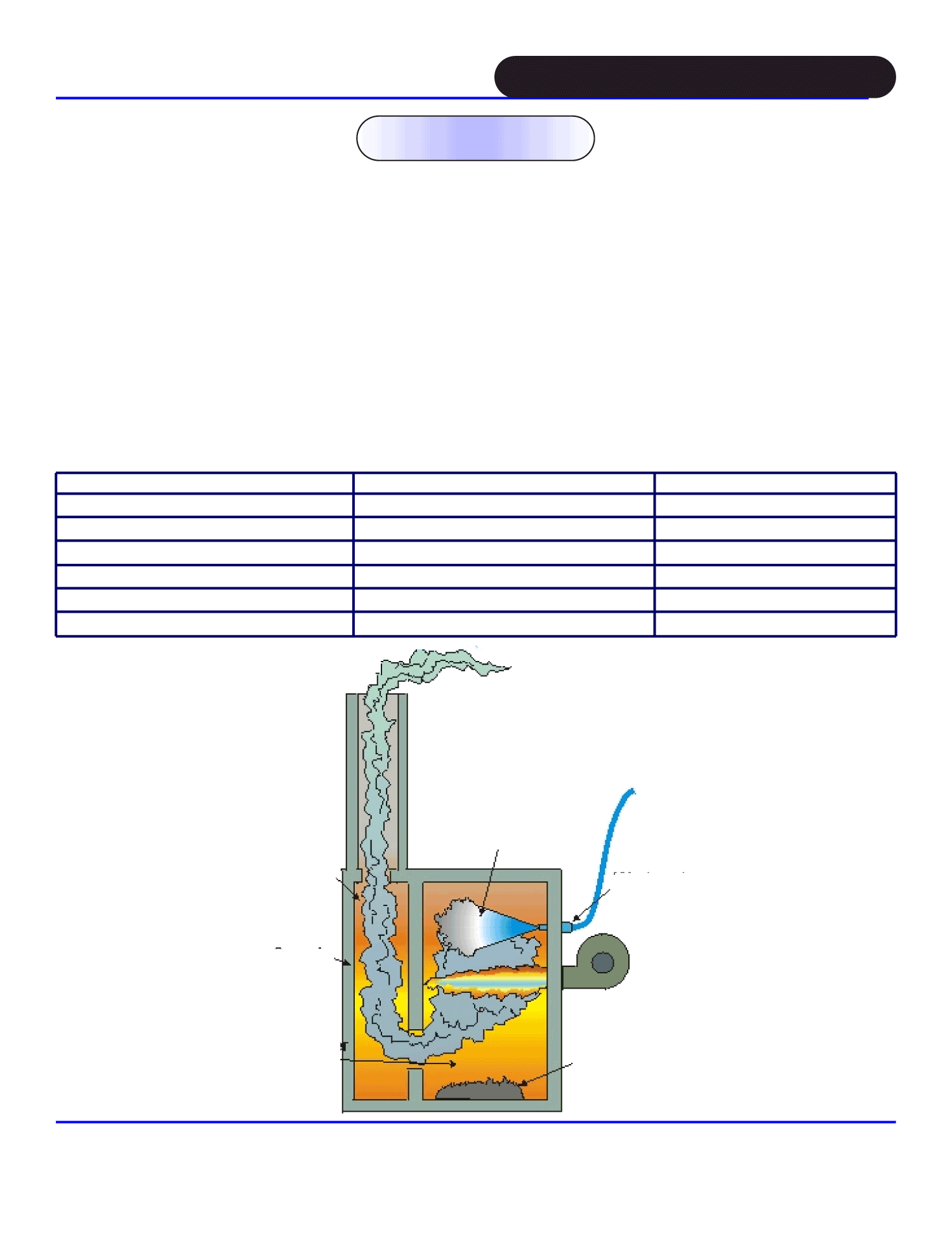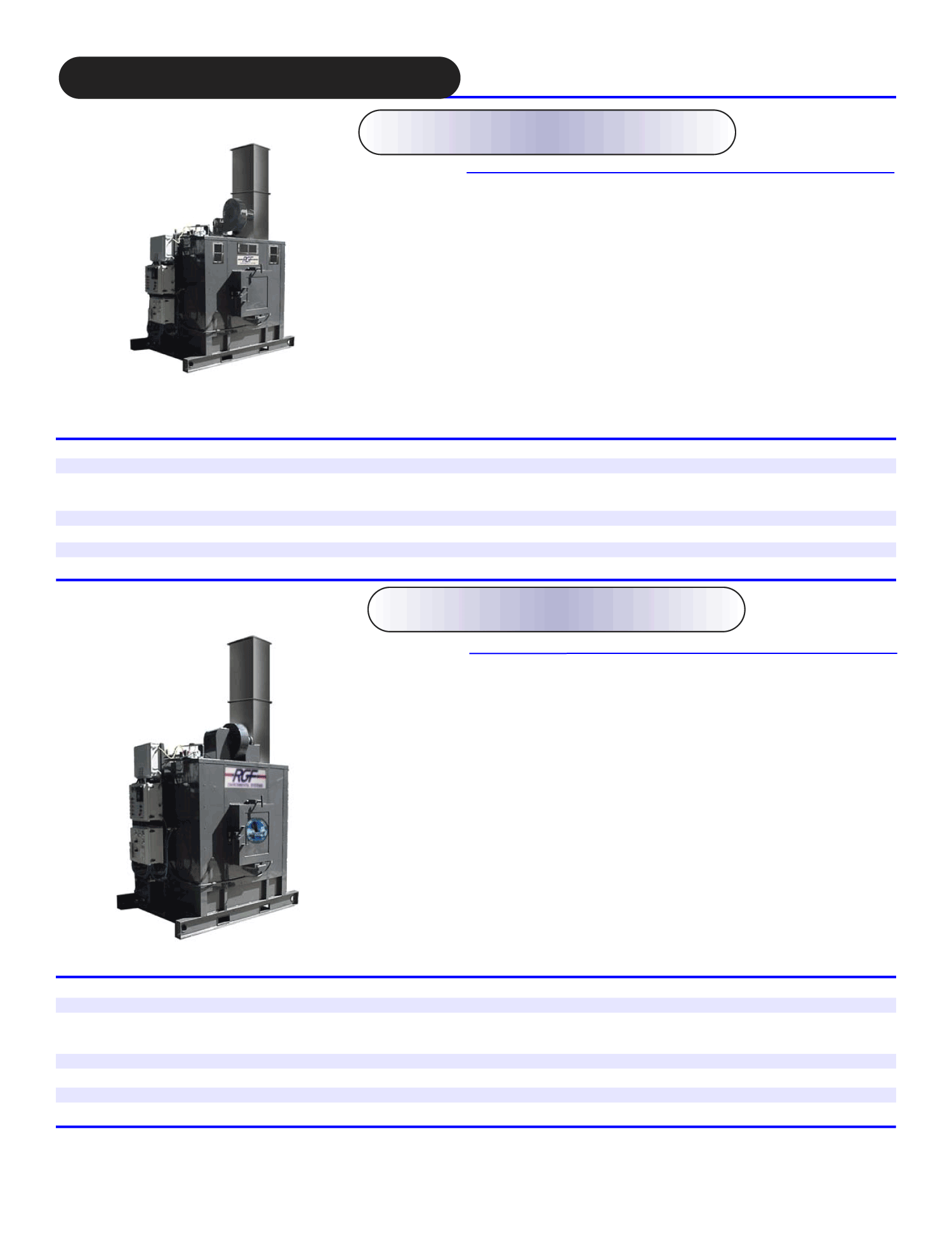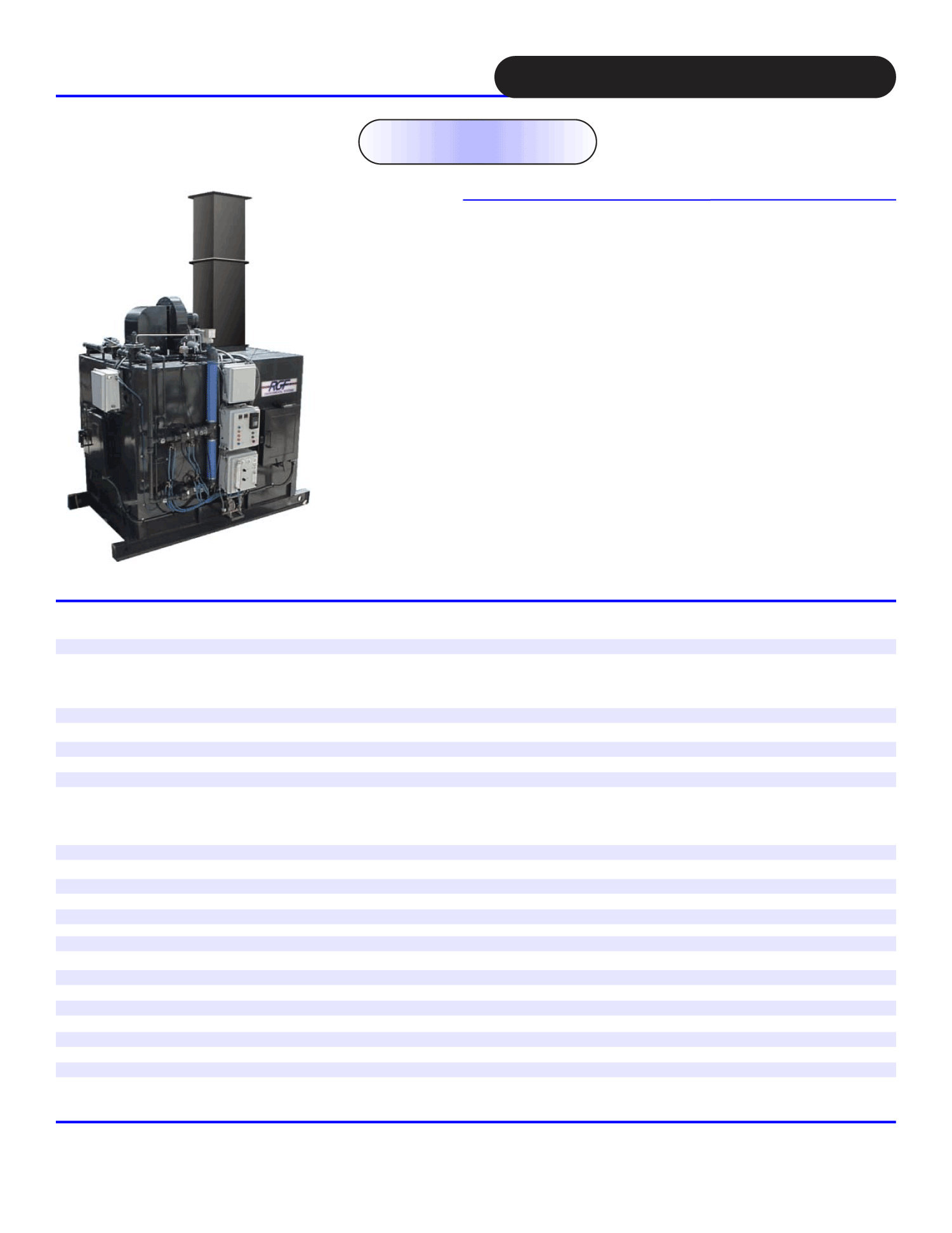Evaporation Systems-101
Evaporation Systems
Evaporation Systems
35
Evaporation of waste wash water occurs during normal operation of the pressure, steam or automatic vehicle wash sys-
tem. It is generally assumed that 10-30% of wash water is lost to evaporation. Accelerated evaporation can be used to
dispose of excessive wastewater, highly contaminated wastewater, or to remove recycled water with high dissolved solid
(TDS) build up.
General Definitions
Evaporation
The process in which a liquid dissipates or emits vapor, fumes, or invisible minute particles.
Distillation
A process that consists of driving gas or vapor from liquids or solids by heating and condensing to liquid products
once again.
BTU’s (British Thermal Unit)
Amount of energy required to raise a 1 lb. mass of water 1°F @ 1 atmosphere.
VOC’s (Volatile Organic Compound)
Organic compound which readily dissipates into the air at room temperature, i.e., benzene, gasoline.
TDS (Total Dissolved Solids)
The amount of ionic matter dissolved in a fluid and can be measured by electric current.
Thermal Oxidation
High temperature breakdown of contaminants to carbon dioxide and water.
TSS (Total Suspended Solids)
Substances suspended in a fluid large enough to be visible by the human eye and small enough to be kept in sus-
pension by the movement of the fluid molecules.
Condenser
An apparatus in which gas or vapor is condensed to a liquid form.
Efficiency
Water evaporation efficiency is based on some basic laws of physics:
It takes 9,274 BTU to evaporate 1 gal. of water from 70
F.
•
o
Natural gas has an approximate heating value of 1,000 BTU
•
f t
3
1 Therm = 100,000 BTU
•
Approximate cost of natural gas is $0.50 per Therm
•
Heat Transfer Equation –
•
Q = UA( T)
Where“Q” = amount of heat transferred
“U” = heat transfer coefficient
“A” = area of heat transfer surface
“ T” =difference in temperature between heated surface of exposed material to be evaporated
and heating environment.
Cost Calculation Example:
Evaporators have a thermal efficiency of 60-80% (average of 70%). For calculations we’ll use 70% efficiency or 14,000
BTU to evaporate one gal of wastewater at sea level.
1000 gal. of wastewater x 14,000 BTU per gal. = 14,000,000 BTU, $0.90/Therm = $70 =
$0.09 cents per gal. evap.
Note: An efficiency factor is present with all evaporators and must be calculated separately.
Evaporation Systems
Evaporation Systems
Methods
Natural Evaporation Ponds
Rely on the combination of solar heat and wind to naturally evaporate water. This method
requires a great deal of area, is slow, and is subject to the weather.
Problems:
– Very slow
– Requires large land mass and pond liner
Forced Air Evaporators
Utilize blowers to force air in a counter current to a spray of water pumped to the top of a column
and free falling downward. The evaporation rate is largely dependent on the water temperature
and the dew point. This method is cost effective and highly efficient when the waste stream to be
evaporated is preheated by another process, and the wastewater does not contain volatile com-
pounds (VOC’s) that would be readily transferred to the air, and thereby create air pollution. Not
recommended for water high in dissolved or suspended solids as they will deposit on the inter-
nals and block the water air flow. This design has no method of removing dried solids. Cost esti-
mates depend on the temperature of the waste stream.
Problems:
– Source water should be preheated by process generating waste.
– Efficiency is dependent on the relative humidity and water temperature.
– Air permitting may be required
Boiling Water Evaporators
Basically heating the water to its boiling point 212°F and exhausting the steam via an exhaust
pipe. This method has no way to remove dried solids other than baking the tank contents down to
a cake, which insulates the heat and holds it into the steel causing early tank failure. Efficiency is
usually 65-75% depending on design. With the addition of a condenser, you can distill the water
for reuse.
Problems:
– Acids and salts will attack the steel
Steam Tube with Water Exhaust Evaporator
Basically the same concept as a Boiling Water Evaporator. However, the hot exhaust gases are
bubbled through the wastewater to improve heat transfer efficiency. VOC’s will be vaporized and
air pollution will result. Dissolved and suspended solids removed periodically by draining a slurry.
Efficiency is 75-85%.
Problems:
– You still have a highly concentrated liquid water slurry to dispose of
– VOC’s will be exhausted as air pollution
– Acids and salts will attack the steel, shortened vessel, and steam tube life
– Air pollution permitting concerns
Heat Exchanger Evaporators
Heat a coil filled with a high temperature oil, which is pumped to another coil inside a tank contain-
ing the waste. The advantage to this system is that the tank can be made of non-corrosive
polypropylene with no direct flame contact. The vapor can be distilled, efficiency is 70-80%.
Problems:
– Air permitting may be required
– Coil failure
Evaporation Systems
Evaporation Systems
Boiler Blow-Off Evaporators
Can evaporate large volumes (2-4 gpm) at a low cost and are effective on pretreated waste
streams. Have no method of collecting or removing of suspended solids. Most of the dissolved
solids are vaporized in the steam at 212°F and blown off into the atmosphere. VOC will be vapor-
ized and will create air pollution. Therefore, all VOC’s and solids must be removed from this sys-
tem. Efficiency is 70-85%.
Problems:
– No method of collecting solids, droplet carryover.
– VOC’s will vaporize and could create air pollution
– Not suitable for distillation for water reuse
Steam Tube Evaporators
Utilize a hot tube as a heat source. The flame is directed inside a steel tube thereby saving the
tank from flame impingement and early failure. The tube will fail. However, it is easily replaceable
and considerably less expensive than the tank. Efficiency is 70-80%. The water is heated to
212°F. The vapor can be distilled and reused.
Problems:
– VOC will be vaporized and will create air pollution
– Dissolved solids and suspended solids are periodically drained off in a slurry solution
and this highly concentrated liquid waste must be disposed of
– Acids and salts will attack steel vessel
– Low tube life expectancy
Liquid Thermal Oxidation
A method of liquid destruction. Through Flash Evaporation the liquid waste is atomized and
sprayed under pressure near a flame. At 1250°F all VOC’s and organics are oxidized, and dis-
solved and suspended solids are thermally oxidized to ash. Efficiency is 70-85%. Solid contami-
nants are reduced to a powdered inorganic ash.
Problems:
– Air permits may be required
Add-On Systems
Vapor Destruction System
Utilize ozone to oxidize remaining exhausting volatile organics followed by activated carbon to neu-
tralize the ozone.
Condensers
A heat exchanger that converts the vapor back to pure distilled water.
Evaporation Systems
Evaporation Systems
RGF Thermo Oxidizer
Wastewater Advantages
The Thermo Oxidizer System completely oxidizes water borne waste streams, leaving only a dry powder as the residual
waste material. Unlike evaporators, the Thermo Oxidizer completely eliminates the water content of the liquid waste. The
unit eliminates the typical evaporator problems of corrosion, foaming, residual slurry, V.O.C. emissions, and difficult to clean
evaporator chambers.
THE CONCEPT
The
is designed to completely oxidize liquid waste, leaving only a dry ash residue. By automati-
Thermo Oxidizer
RGF
cally controlling the fuel modulation and the waste flow, maximum efficiency is achieved resulting in a fuel cost as low as
$0.10 per gallon.
utilizes a cast ceramic refractory for all interior combustion surfaces to eliminate corrosion and
RGF
metal failure. By utilizing an optional waste oil burner, the system can eliminate both waste oil and wastewater.
ADVANTAGES OF THERMO OXIDIZER FLASH EVAPORATION
Lower Cost Of Fuel
No Residual Slurry
Traditional evaporators utilize a wastewater reservoir of 50-
Traditional evaporators require a periodic removal of the con-
200 gallons, which must be heated and maintained to 212° F,
centrated slurry, which can consist of highly concentrated haz-
requiring a lot of wasted energy.
Flash Evaporator
RGF’s
ardous wastes presenting a disposal problem.
Flash
RGF’s
Process sprays a high pressure controlled atomized flow
Evaporator Process
directly into the flame, thereby eliminating the 50-200 gallon
totally oxidizes the
heated water mass, which results in a cost as low as $0.10 per
waste to ash, which
gallon. With the waste oil burner option, fuel cost is reduced.
may be disposed of as
Additional savings can be realized with the complete elimina-
non-hazardous. In
tion of both waste oil and water.
cases of highly con-
Reduced Air Emissions
taminated waste
Traditional evaporators simply heat water to 212° F, or boiling
streams, the oxidizer
Residue from 2,000 gal. of
point, which produces steam to evaporate the waste away.
is set for 1,400° F,
parts washer waste
However, V.O.C. – Volatile Organic Compounds are also driv-
which will render almost
en off with the steam producing air pollution problems that
any waste harmless.
could far exceed your wastewater problems.
Flash
RGF’s
No Corrosion
Evaporator Process will combust V.O.C. as the waste stream
Traditional Evaporators utilize a waste stream reservoir where
is atomized and sprayed under pressure into the chamber not
the water is heated to 212° F, or boiling, to produce steam
into the flame. A high fire setting is available with secondary
which is vented off as air emissions. The problem is heat,
chamber temperature of 1,400-1,600° F., 1,250° F is general-
water and steel do not mix well and, when added to the water
ly accepted as a total oxidation temperature for hydrocarbons.
chlorides and sodium, create a real corrosion problem. Even
expensive stainless steel will develop stress corrosion, crack-
ing, carbide precipitation, and inter granular corrosion, result-
ing in early failure.
, therefore, developed a high temper-
RGF
ature ceramic liner for the wet combustion chamber thereby
eliminating corrosion problems.
Evaporation Systems
Evaporation Systems
RGF Thermo Oxidizer
Applications
RGF Thermo Oxidizer Flash Evaporator
The Thermo Oxidizer was designed by RGF to completely oxidize liquid waste, leaving only ash to dispose. The unit
meets NFPA86 Fire Safety Code requirements.
Unlike a stainless steel evaporator, the Thermo Oxidizer is not subject to chloride stress crack corrosion. It is easily
cleaned and requires little maintenance. The biggest difference is the total removal of water content by the Thermo
Oxidizer. The wastewater does not accumulate, making it impossible for the wastewater to concentrate. This is an
operational asset in that the emissions are not permitted to worsen with time, as they are with an evaporator.
Typical temperature settings range from 800 to 1,400oF. Incinerators operate between 1,800 and 3,000oF. The Thermo
Oxidizer works to thermally decompose chemicals within the wastes to their primary combustion products of CO2, H2O,
and simple compounds. At temperatures of 700oC, most chemicals are broken down into smaller molecular weight con-
stituents, and at temperatures of 1000oC, the majority of wastes are reduced to ash.
So what types of waste streams are applicable for treatment by the Thermo Oxidizer?
Petroleum Hydrocarbon Waste
RO, NF, UF Concentrators
Floor Scrubber Waste
·
·
·
Die Casting
Tumbling Solutions
Plating Solutions
·
·
·
Alkaline Cleaners
Waste Haulers
Textiles
·
·
·
Machinery Coolants
Process Wastewater
Heavy Equipment
·
·
·
Compressor Wastes
Printed Circuit Board Waste
Food Processing
·
·
·
Ink and Paint Waste
Tanker Cleaning
Manufacturing Processes
·
·
·
Electro Polishing Rinse Waters
Diesel Injector Cleaning
Oil Field Tool Cleaning
·
·
·
Thermally Oxidized
Combustion Gases
and Water Vapor
Hot Gases
Thermal
Oxidation
Chamber
Wastewater
Atomizer
Ceramic Liner
Dry Chamber
Dry Ash
Flash
Containing
Evaporator
Contaminants
Evaporation Systems
Evaporation Systems
RGF Thermo Oxidizer Flash Evaporator
Model TO-30 (30 gph)
Specifications
F
u
e
l
:
N
G
o
r
L
P
Dimensions:
5’-2″W X 7’-2”D X 7’-10”H (w/o stack)
Electrical Requirements:
110VAC – 20 Amp – 1 Phase
Disposal Rate:
Up to 30 Gallons per hour, clean water
Construction:
Steel Plate / Ceramic Lined / S.S. Door
Air Supply Requirements:
12 SCFM @ 100 PSI
Typ. Temperature Settings:
800-1,400 F
Burner Safeguard Control:
UL,CSA Listed, FM And IRI Approved
Flame Monitor:
Flame Rod
Exterior Finish:
High Temp. Two-Part Polyurethane
Stack Height from Floor:
18’-6”
Other power available
US Patent #: 6546883
Description
Item #
Waste Evaporation Rate
Ship Weight
RGF Thermo Oxidizer TO-30 Wastewater Evaporator
TO-30-Y
Up to 30 gph
9,000 Lbs.
Item #
Suggested Accessories
OP-103-30
Spare Parts Kit
OI-058
Waste Oil Burner Option Installed (Does not include Oil Tank) 350,000 BTU
SA-148-2-Y
4’ H TO-30 Stack Section Unported
SA-149-2-Y
4
’
H
T
O
–
3
0
S
t
a
c
k
S
e
c
t
i
o
n
P
o
r
t
e
d
S
e
e
R
e
p
l
a
c
e
m
e
n
t
p
a
r
t
s
n
e
x
t
p
a
g
e
OP-116
200 Micron Prefilter Assembly
RGF Thermo Oxidizer Flash Evaporator
Model TO-60 (60 gph)
Specifications
F
u
e
l
:
NG or LP
Dimensions:
6′-6″W X 6′-0”D X 8’-10”H (w/o stack)
Electrical Requirements:
230VAC – 20 AMP – 1 or 3 Phase
Disposal Rate:
Up to 60 Gallons per hour, clean water
Construction:
Steel Plate / Ceramic Lined / S.S. Door
Air Supply Requirements:
23 SCFM @ 120 PSI
Typ. Temperature Settings:
800-1,400 F
Burner Safeguard Control:
UL, CSA Listed, FM And IRI Approved
Flame Monitor:
Flame Rod
Exterior Finish:
High Temp. Two-Part Polyurethane
Stack Height from Floor:
19’-6”
Other power available
US Patent #: 6546883
Description
Item #
Ship Weight
Waste Evaporation Rate
RGF Thermo Oxidizer TO-60 Wastewater Evaporator
TO-60-Y
11,000 Lbs.
Up to 60 gph
Item #
Suggested Accessories
OP-103-60
Spare Parts Kit
OI-058
Waste Oil Burner Option Installed (Does not include storage tank) 350,000 BTU
SA-148-Y
4’ H TO-60 Stack Section Unported
SA-149-Y
4
’
H
T
O
–
6
0
S
t
a
c
k
S
e
c
t
i
o
n
P
o
r
t
e
d
S
e
e
R
e
p
l
a
c
e
m
e
n
t
p
a
r
t
s
n
e
x
t
p
a
g
e
OP-116
200 Micron Prefilter Assembly
Evaporation Systems
Evaporation Systems
RGF Thermo Oxidizer
Model TO-150 (150 gph)
Specifications
F
u
e
l
:
N
G
o
r
L
P
D
i
m
e
n
s
i
o
n
s
:
1
0
’
–
6
”
L
X
6
’
D
X
8
’
–
1
0
”
H
Electrical Requirements:
120 VAC – 5 A – 1 Phase
460 VAC – 10 A – 3 Phase
Disposal Rate:
Up to 150 Gallons per hour, clean water
C
o
n
s
t
r
u
c
t
i
o
n
:
3
/
1
6
”
S
t
e
e
l
P
l
a
t
e
/
C
e
r
a
m
i
c
L
i
n
e
d
/
S
.
S
.
D
o
o
r
Air Supply Requirements:
43 SCFM @ 100 PSI
Typ. Temperature Settings:
800-1,400 F
Burner Safeguard Control:
UL,CSA Listed, FM And IRI Approved
Flame Monitor:
Flame Rod
Exterior Finish:
High Temp. Two-Part Polyurethane
Stack Height From Floor:
19’-10”
* Other powers available. Contact factory
US Patent #: 6546883
Waste Evaporation Rate
Description
Item #
Ship Weight
Up to 150 gph
23,000 Lbs
RGF Thermo Oxidizer TO-150 Wastewater Evaporator
TO-150-Y
.
Item #
Suggested Accessories
Spare Parts Kit
OP-103-150
Waste Oil Burner Option Installed 350,000 BTU (Does not include storage tank)
OI-058
4’ H TO-150 Stack Section Unported
SA-148-1-Y
4’ H TO-150 Stack Section Ported
SA-149-1-Y
200 Micron Prefilter Assembly
OP-116
Item #
Replacement Parts (All Models)
EL-050
10Amp DPDT Relay
EL-162
Contact Block
EL-167
Contact Block
EL-200
2 Output Temp Controller 120/60
EL-201
High Temp Limit Controller 120/60 AC
EL-202
Type “K” Thermocouple
EL-218
Indicators/Switch Light Bulb
EL-243
Flame Rod
EL-244
Spark Ignitor
EL-263
2 Burner Flame Safeguard Relay
PT-199
Air Regulator
PT-169
Nozzle Fluid Cap Gasket
PU-102-1
Air Service Kit for 1” Diaphragm Pump
PU-102-2
Fluid Service Kit for 1” Diaphragm Pump
VA-086
Solenoid Coil
VA-089
1/4” Solenoid Valve Assembly
VA-100
3/4” 120V Brass Solenoid Valve
All of the Above Replacement Parts Can be ordered in 1 Spare parts Package for the TO-150 Using
Note:
Item # OP-103-1
Click Here for PDF



